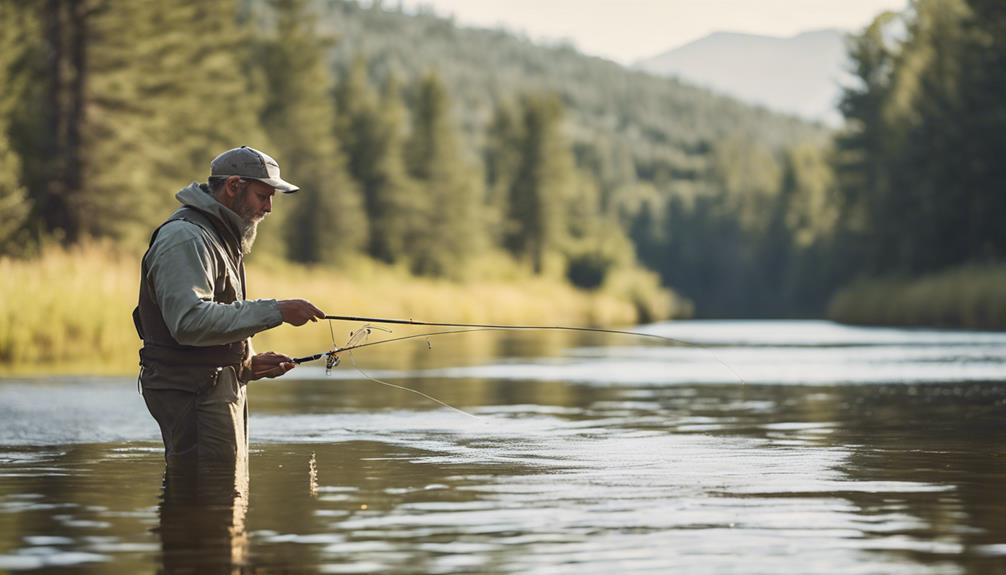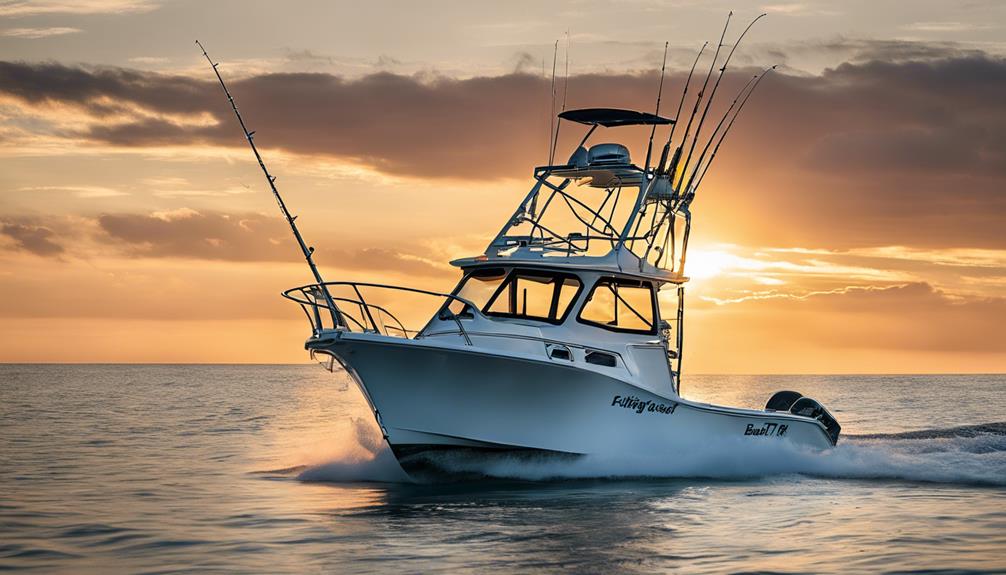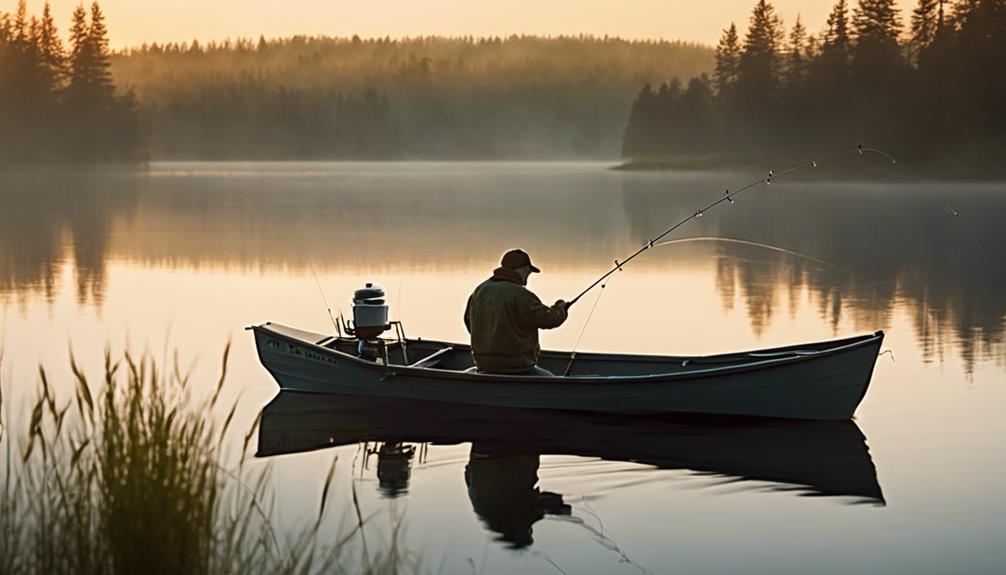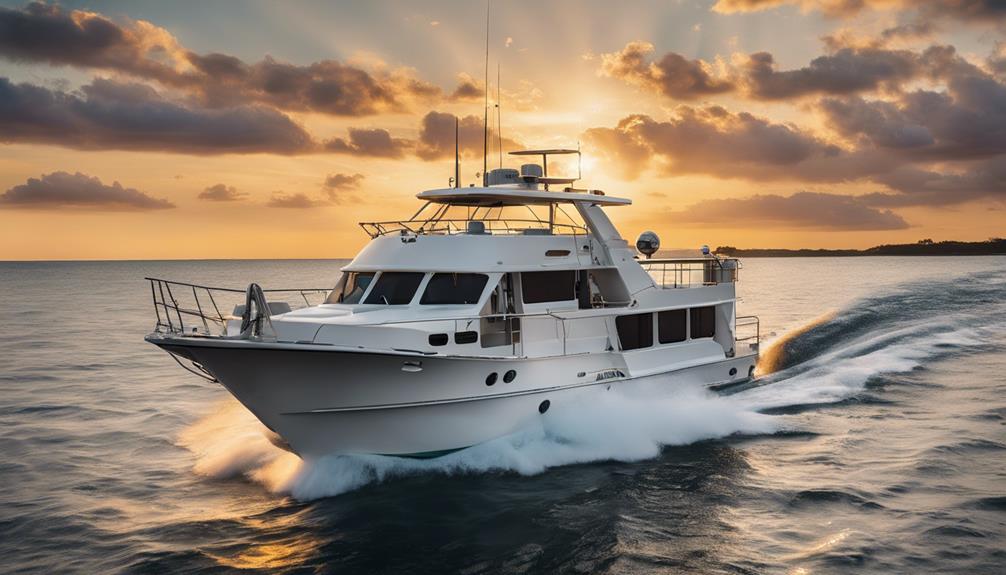When practicing catch and release fishing, remember these essential tips: Use barbless hooks for easy removal and sensitive gear for minimal stress. Handle fish with wet hands and avoid gills, supporting them gently. Remove hooks swiftly and cut lines if needed. Barbless hooks reduce harm and aid survival. Minimize fight time with proper gear and technique. Release fish in sheltered areas, near capture sites, and watch for stress signs. Educate others on sustainable fishing practices. Adhering to these guidelines fosters fish conservation and ecosystem protection. Mastering these techniques ensures successful catch and release practices.
Selecting the Right Equipment
When choosing equipment for catch and release fishing, prioritize using barbless hooks to minimize harm to the fish. Selecting the right rod, reel, and line plays a crucial role in ensuring a successful catch and release experience while maintaining the well-being of the fish population. Opt for a rod with a sensitive tip that allows you to feel even the slightest nibbles, increasing your ability to hook the fish without delay. Pair this with a reel that provides smooth drag to prevent line breakage during the fight. Additionally, using a quality line that's strong yet thin can help reduce exhaustion for the fish during the retrieval process.
Proper bait selection is equally vital in catch and release fishing. Choose artificial baits over live ones to decrease the chances of deep hooking, which can cause severe harm to the fish. Artificial baits also have the benefit of being reusable, reducing the impact on the environment. Opt for lures that mimic the natural prey of the fish species you're targeting to increase the likelihood of a successful hook without causing unnecessary harm.
Understanding Proper Handling Techniques
To ensure the well-being of the fish during catch and release fishing, mastering proper handling techniques is essential. Handling stress during the catch and release process is crucial for the fish's survival. When handling a fish, always wet your hands to prevent removing its protective slime layer, which can lead to infections and decreased chances of survival. Avoid touching the gills as they're sensitive and essential for the fish's respiration. Support the fish gently, keeping it close to the water to minimize air exposure.
Fish protection should be a top priority. Never squeeze the fish tightly, as this can cause internal injuries. When holding the fish, use a wet and knotless landing net to prevent damage to its scales and fins. Avoid dropping the fish or letting it flop around, as this can result in physical harm. If the fish struggles, hold it gently but securely until it calms down before releasing it back into the water.
Practicing Proper Hook Removal
Properly removing the hook from a fish is a critical aspect of catch and release fishing to minimize harm and increase the fish's chances of survival. When practicing proper hook removal, the utmost care must be taken to ensure the safety of both the fish and the angler. Hook safety is paramount to prevent further injury to the fish. To achieve this, always handle the fish gently and securely to avoid unnecessary stress.
Injury prevention is a key consideration when removing the hook. Before attempting to remove the hook, ensure that you have the necessary tools readily available, such as needle-nose pliers or a hook remover. These tools can help safely extract the hook without causing additional harm to the fish. It's essential to work swiftly but delicately to minimize the time the fish spends out of the water.
When removing the hook, be mindful of its location. If the hook is deeply embedded, it may be best to cut the line rather than causing more damage trying to dislodge it. Remember, the goal is to release the fish with minimal harm. After successfully removing the hook, gently place the fish back in the water, supporting it until it swims away on its own. By following these guidelines for proper hook removal, you can contribute to the conservation of fish populations and ensure a successful catch and release experience.
Using Barbless Hooks
Consider using barbless hooks to reduce harm to fish during catch and release fishing. Barbless hooks are designed without the traditional barb found on standard hooks. This design alteration plays a crucial role in hook safety for fish as it minimizes tissue damage and makes hook removal easier and less traumatic. When a fish is hooked with a barbless hook, the absence of the barb allows for a quicker and gentler extraction, reducing stress and injury to the fish.
Barbless hooks offer several benefits that align with the conservation principles of catch and release fishing. By choosing barbless hooks, you can significantly decrease the time and effort required to remove the hook from the fish, which in turn lessens the fish's exposure to potential harm. Furthermore, the reduced handling time associated with barbless hooks can enhance the fish's chances of survival post-release. This aspect is particularly important in ensuring the well-being and sustainability of fish populations in the ecosystem.
Minimizing Fight Time
Minimizing fight time when engaging in catch and release fishing is essential for reducing stress on the fish and optimizing its chances of survival. When fish are hooked, the fight that ensues can be exhausting for them, leading to increased stress levels and potential injuries. By minimizing the time it takes to land a fish, you can significantly reduce the negative impact on its well-being and contribute to the conservation of fish populations.
To minimize fight time and promote the well-being of the fish, consider the following tips:
- Use the Right Gear: Opt for appropriate fishing gear that matches the targeted fish species. Using heavier gear than necessary can prolong the fight and tire out the fish unnecessarily.
- Set the Drag Properly: Adjust your drag settings to ensure that the fish can take line when needed, preventing it from breaking off, but also providing enough resistance to bring it in efficiently.
- Maintain Proper Technique: Employ proper angling techniques to bring the fish in swiftly without overly exerting it. Avoid jerking the rod or applying excessive pressure that can prolong the fight.
- Stay Attentive: Pay close attention to the fish's movements and act promptly to guide it towards a successful landing. Being attentive can help shorten the fight time and reduce stress on the fish.
Supporting Fish During Release
Supporting the fish during release is crucial for ensuring its successful transition back into its natural habitat and promoting its overall well-being. Fish stress is a significant concern during catch and release, as the struggle and handling can lead to exhaustion and potential harm. To support the fish effectively, you must minimize the time it spends out of the water. When handling the fish, ensure your hands are wet to protect its delicate mucous layer, which acts as a defense against infections and parasites. Avoid squeezing the fish tightly or dropping it onto hard surfaces, as this can cause injuries that may impact its survival post-release.
Furthermore, consider the water temperature when releasing the fish. Warmer water holds less oxygen, making it harder for fish to recover after the stress of being caught. In such conditions, it's crucial to work quickly and efficiently to minimize the time the fish spends out of the water. If the water temperature is particularly high, consider moving to a cooler, shaded area for the release. Remember that your goal is to give the fish the best chance at a successful recovery and survival after being caught. By supporting the fish during release, you contribute to the conservation of fish populations and aquatic ecosystems.
Choosing the Right Release Spot
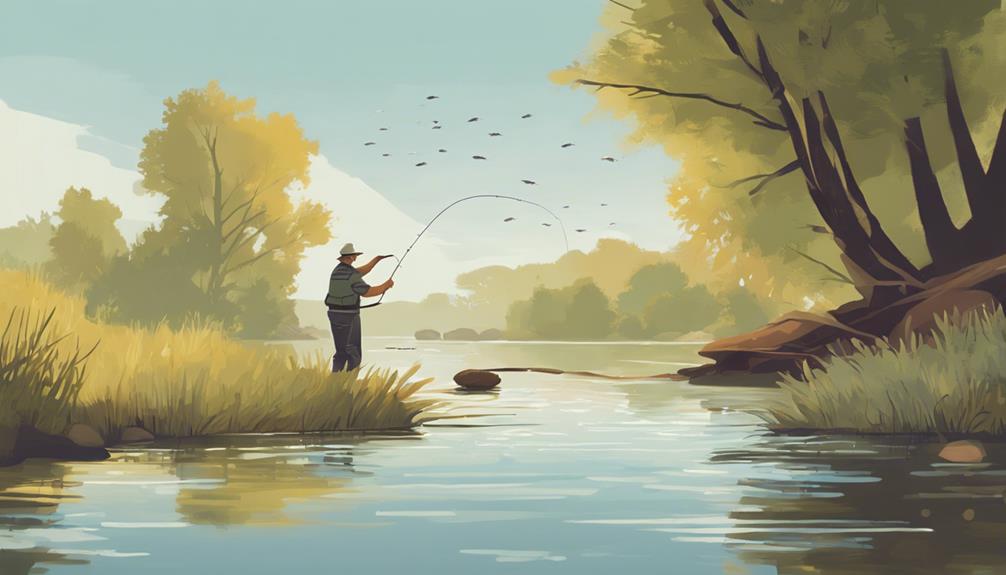
When selecting the appropriate spot for releasing a fish back into the water after catching it, prioritize areas with optimal oxygen levels and suitable habitat conditions to support its recovery and survival. The release location plays a crucial role in minimizing the environmental impact and reducing fish stress, ultimately increasing the chances of successful reintegration into their natural environment.
- Oxygen-rich Zones: Choose release points in areas with high oxygen levels to ensure the fish can breathe properly and recover swiftly.
- Sheltered Areas: Opt for spots with suitable habitat features like underwater vegetation or rock structures where the fish can seek refuge and regain strength.
- Avoiding High-Traffic Areas: Release the fish away from busy fishing spots or boat lanes to prevent additional stress and potential harm.
- Proximity to Capture Site: Whenever feasible, release the fish close to where it was caught to enhance familiarity and reduce disorientation post-release.
Selecting an appropriate release point is vital in safeguarding the well-being of the fish and maintaining the delicate aquatic ecosystem. By considering these factors, you can contribute to the conservation of fish populations and promote sustainable recreational fishing practices.
Monitoring Fish Behavior Post-Release
To ensure the successful reintegration of the fish into their natural environment, closely monitor their behavior post-release for signs of stress or disorientation. Observing fish after release is crucial in understanding how they acclimate to their surroundings. Look for erratic swimming patterns, lethargic movements, or fish that remain at the surface, as these could indicate distress. Tracking movements can provide valuable insights into the fish's recovery process. If a fish appears disoriented, gently guide it in a figure-eight pattern in the water to help oxygenate its gills and assist in regaining its bearings. Remember, stress can have long-lasting effects on fish health, so minimizing this impact is essential for their survival.
After releasing a fish, take the time to observe its behavior from a distance. Avoid disturbing the fish unnecessarily, as this can hinder their ability to recover. Note how the fish interacts with its environment, whether it explores its surroundings or seeks shelter immediately. By monitoring fish post-release, you contribute to the conservation of fish populations by ensuring their well-being after the catch. This information can also help improve catch and release practices in the future, promoting sustainable fishing practices for generations to come.
Educating Others About Catch and Release
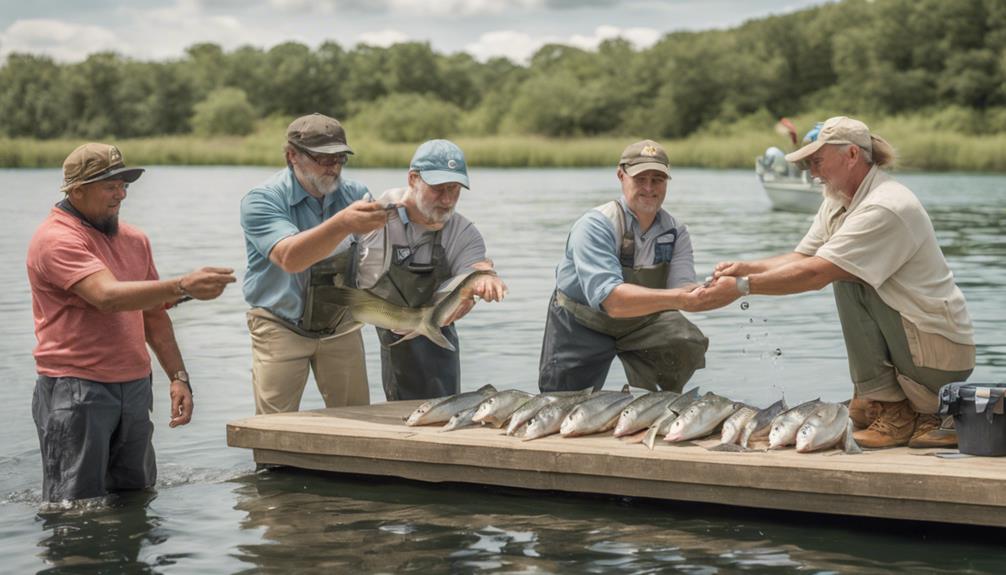
Educate others about catch and release fishing practices to promote sustainable conservation efforts and protect fish populations for future generations. By spreading awareness and knowledge, you can make a significant impact on preserving aquatic ecosystems.
Here are some key points to consider:
- Conservation awareness: Engage in discussions with fellow anglers, local communities, and schools about the importance of catch and release fishing. Highlight the role it plays in maintaining healthy fish populations and the overall balance of the ecosystem.
- Education methods: Utilize social media platforms, workshops, and informational pamphlets to share best practices for catch and release. Emphasize the proper handling techniques, such as minimizing air exposure and using barbless hooks, to increase the chances of survival post-release.
- Sustainability practices: Encourage the adoption of sustainable fishing practices, including adhering to catch limits, using circle hooks to reduce deep hooking, and releasing fish gently back into the water. Emphasize the long-term benefits of these practices for both anglers and the environment.
- Outreach strategies: Collaborate with conservation organizations, fishing clubs, and government agencies to organize outreach events and educational programs. By working together, you can amplify the message of responsible fishing practices and conservation efforts to a broader audience, fostering a culture of environmental stewardship.
Frequently Asked Questions
Can Catch and Release Fishing Harm Fish Populations?
Catch and release fishing, when done improperly, can indeed harm fish populations. It's crucial to prioritize fish conservation by following ethical angling practices. Proper handling techniques, quick release, avoiding overexertion, and using barbless hooks are essential.
Respecting catch limits and regulations also play a significant role in maintaining healthy fish populations. By practicing responsible catch and release methods, you can contribute to the sustainability of fish populations and the overall health of aquatic ecosystems.
What Are the Best Practices for Reviving Exhausted Fish?
To revive exhausted fish effectively, gently support them in the water, allowing oxygen to flow through their gills. Avoid excessive handling and never touch their gills. Keep the fish upright to aid in proper breathing.
Conservation efforts rely on these reviving techniques to ensure fish survival post-release. Using proper handling and release strategies contributes to maintaining healthy fish populations in our waters.
Is Catch and Release Fishing Legal in All Areas?
Yes, catch and release fishing is legal in many areas, but regulations vary. It's crucial to check local laws to ensure compliance.
Environmental impact and ethical considerations are at the forefront of catch and release practices. Setting catch limits and supporting conservation efforts help maintain fish populations.
How Can Anglers Reduce Stress on Fish During Handling?
To reduce stress on fish during handling, it's crucial to minimize air exposure, use proper handling techniques, and avoid removing protective slime.
Gentle handling, keeping fish in the water whenever possible, and using barbless hooks can all help.
Swift releases and avoiding excessive handling time are key in fish handling for stress reduction.
Are There Specific Regulations for Catch and Release Fishing?
When engaging in catch and release fishing, it's crucial to be aware of specific regulations in place. These regulations often include catch limits, which restrict the number of fish that can be kept, and conservation measures designed to protect fish populations and their habitats.
Conclusion
In conclusion, implementing these top 9 tips for successful catch and release fishing is crucial for the conservation of fish populations. By using the right equipment, handling techniques, and release practices, anglers can ensure the health and survival of the fish they catch.
It's important to remember that responsible fishing practices not only benefit the individual angler, but also contribute to the sustainability of our aquatic ecosystems. Share your knowledge and advocate for catch and release practices to protect our precious marine resources.
